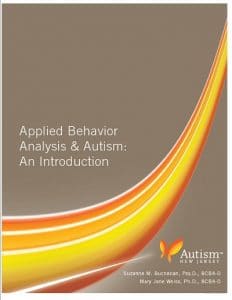Buchanan, S., & Weiss, M. J. (2010). Applied Behavior Analysis and Autism: An Introduction. Robbinsville, NJ: Autism New Jersey.
Reviewed by Lesley A. Shawler, PhD, BCBA
Association for Science in Autism Treatment

Applied Behavior Analysis and Autism: An Introduction
Learning your child has autism and the various therapies that exist can be an overwhelming and frightening experience. Autism New Jersey has published a useful resource for parents interested in learning about one evidenced-based therapy: applied behavior analysis (ABA). The authors describe and discuss this therapy in an easy to digest and understandable manner for those just learning about it. Throughout the book, there are numerous relatable examples and descriptions of important behavioral principles, concepts, and evidenced-based teaching methodologies. The authors also provide a large list of additional resources for parents and families interested in learning various topics related to ABA.
This book begins with the importance of behavior analysis as well as by providing evidence-based support of its efficacy with individuals with Autism Spectrum Disorder (ASD). Specifically, the book highlights strategies for the reduction of aberrant or challenging behaviors, as well as methods to increase adaptive and functional types of behaviors. It then proceeds to discuss the behavioral perspective of learning as it relates to both past experiences as well as the current learning environment which is generally different from more traditional explanations of behavior. Parents are taught how to determine the A-B-Cs (antecedents, behaviors, and consequences) of behavioral episodes, to better identify what is (or is not) leading to behavior pattern.
The majority of the book is dedicated to describing some of the various behavioral principles and teaching methods that comprise ABA. Specifically, some examples include shaping, reinforcement, modeling, and prompting. A few of the teaching interventions mentioned include discrete trial training, natural environment training, pivotal response training, and the picture exchange communication system. Each concept is described in more technical terms, to appeal to behavior analysts, but is also broken down into more user-friendly terminology so that others less familiar with behavior analysis may understand. This includes many examples related to individuals with ASD, as well as common everyday examples. Each concept provides a specific reference so that others can seek out more information for topics of interest.
Importantly, the authors provide a section on how to identify the functions of challenging behaviors by completing assessments in the form of observation of the child and interviews with relevant caregivers. The accurate identification of challenging behaviors has led to the development of successful function-based treatments for numerous individuals displaying these types of behavior. This summary includes real-life examples and instructions on how to identify the potential variables that may be contributing to certain behaviors. This process is broken down and explained so that parents may learn how to observe and identify patterns that could be contributing to their child’s behaviors. This analysis allows for an important, but often under discussed area of using proactive and preventative strategies. It is important for families to be proactive when dealing with difficult situations, rather than just reacting once the problem behavior has occurred. The book provides support and suggestions with the use of several examples as to how these modifications can occur to promote more successful behavior management.
Perhaps one of the most unique contributions of this book includes sections dispelling different myths and facts. The long history of ABA both within the science and its practice have led to a plethora of misconceptions within the field. This can be confusing for consumers of ABA who have difficulty discerning fact from fiction. The authors detail some of the more common myths as well as the facts that correspond to them. This section should be applauded as a step in the right direction to promoting honest evidenced-based treatment.
The book concludes with some important considerations for parents when dealing with in-home therapy sessions, the role that family and siblings can play for their loved one with ASD, and some basic considerations for the behavior analysts working with their children. There is even a section on identifying the hallmarks of a high-quality ABA program, an often overlooked area when working with families. In fact, many of these topics are often under emphasized or disregarded during training new families securing ABA therapy for the first time. A family receiving guidance on navigating the ins and outs of these services is key for the success of their child. These sections provide a starting point for parents to consider when setting up ABA therapy for their children.
In summary, this book provides a great overview of Applied Behavior Analysis for new families attempting to navigate the intimidating world of autism treatments. With so many options and contradictory information available, this book is recommended as a comprehensive guide where information on specific behavioral principles and teaching procedures can be accessed.
Citation for this article:
Shawler, L.A. (2019). [Review of the book Applied behavior analysis and autism: An introduction, by S. Buchanan and M. J. Weiss]. Science in Autism Treatment, 16(8).

